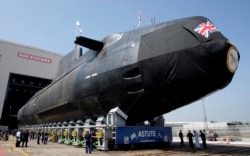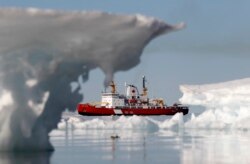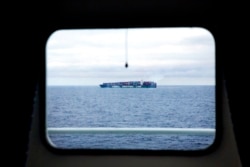British sailors will begin training aboard Canadian icebreakers in a new agreement that reflects the United Kingdom’s heightened interest in developing a more robust Arctic military capability.
Britain is just the latest nation to focus fresh attention on the far north as climate change opens the region to new opportunities for navigation and resource exploitation. Countries as diverse and distant as China, Turkey and India are also eyeing the region.
The U.K.-Canada agreement, signed earlier this month, calls for British sailors to train aboard Canada’s fleet of 20 Coast Guard icebreakers as they crunch their way through the Arctic ice sheets, clearing the way for other vessels to access the once-fabled Northwest Passage.
“The sharing of the Canadian Coast Guard’s wide experience and expertise will mean British sailors are better-equipped when sailing to the frozen region,” the Royal Navy said in a formal statement.
The Canadians, for their part, hope to benefit from the Royal Navy’s “operational experience and expertise,” according to a statement from Canada’s Coast Guard commissioner.
Nuclear submarines
While lacking Canada’s long experience in the ice, Britain has other assets to bring to an enhanced relationship in the region, most notably a fleet of nuclear-powered submarines that can remain under the ice far longer than anything Canada possesses.
“While Canada naturally retains the primary responsibility for the defense of the Canadian Arctic, it has never had all the hardware necessary” including nuclear submarines says Adam Lajeunesse, a top Canadian expert in Arctic security. In military circles, nuclear submarines are often referred to as SSNs.
“As has long been the case, Canada needs American or British support since it lacks the SSNs needed to test sensor networks or respond to trespassers,” Lajeunesse told VOA. “For their parts, the U.S. and British will need Canadian participation.”
Canadian defense expert Jeffrey Collins, an assistant political science professor at the University of Prince Edward Island, agreed that Britain “has plenty of submarine experience in the Arctic.” But, he said, “gaining surface naval Arctic experience is a must if they are intent on being a player in the region in terms of strengthening its post-Brexit U.S. alliance.”
According to Samuel Jardine, a research director at London Politica, a political risk advisory, Canada balked at the U.K.'s offer of Royal Navy assets such as the submarines to help it patrol the Arctic.
“The latest agreement between the Canadian Coast Guard and British Royal Navy on Arctic cooperation and training is progress, but a far cry from where security cooperation should be from the U.K.’s perspective,” he said in an interview.
Jardine said the main obstacle to U.K.-Canada cooperation is the British and American view that the Northwest Passage is international waters, while Canada claims it as Canadian territory. Jardine said that as climate change pushes back the Arctic ice cap, disagreements between Britain and Canada could further threaten Arctic cooperation.
So far, however, both nations have participated constructively in international research in the region, including on projects such as the Multidisciplinary Drifting Observatory for the Study of Arctic Climate, or MOSAiC.
“Scientifically both the U.K. and Canada enjoy an extensive cooperative relationship in the Arctic,” Jardine said. “Particularly on research surrounding climate change, an issue that both states have placed as a key pillar of their domestic and foreign policy agendas.”
Britain's post-Brexit strategy
While the reasons for Canada’s interest in the Arctic are obvious, Britain’s interest has been heightened by its pursuit of a geostrategic realignment following its departure from the European Union.
“A prerequisite recognized in U.K. government circles for Britain’s post-Brexit ‘Pacific tilt’ to succeed is a peaceful and stable ‘high north,’ — which, after all, sits on Britain’s doorstep,” Jardine said.
“An Arctic that is increasingly militarized and a venue for ‘great power’ competition imperils London’s ability to marshal and direct the hard and soft power assets needed to make its Indo-Pacific project an economic and strategic success.”
The Arctic partnership with Canada also meshes with Britain’s post-Brexit goal of building closer ties with other Commonwealth members, as does its participation with the United States in the recent AUKUS agreement that will provide nuclear submarines to Australia.
Other countries have made calculations similar to Britain's and are pursuing observer status with the Arctic Council, a group of eight nations ringing the Arctic Circle who convene to resolve disputes and address common concerns. The members are Canada, Denmark, Finland, Iceland, Norway, Russia, Sweden and the United States. Observer status is enjoyed by another 13 countries including Poland and Singapore.
China's Arctic goals
China, with its globe-spanning quest to secure long-term access to natural resources, acquired observer status in the Arctic Council in 2013 and, five years later, declared itself a “near-Arctic state,” raising eyebrows, given that it is almost 1,500 kilometers from the Arctic Circle.
Also in 2018, Beijing’s State Council Information Office issued a policy white paper declaring that China “hopes to work with all parties to build a ‘Polar Silk Road’ through developing the Arctic shipping routes,” Reuters reported.
Lajeunesse said the Arctic powers are unlikely to see Chinese naval vessels in the region any time soon. “More likely, the West will see a hybrid threat emerge in the form of Chinese fishing fleets and quasi-state vessel operations.”
“Canada and the U.S. will need to expand joint monitoring of the Arctic Ocean to keep track of these ships (and others that may be there),” Lajeunesse said, “ensuring that there are not violations of our waters, illegal fishing, or other activity that may need to be monitored or controlled.”
The prospect of accelerating climate change has other countries looking northward as well.
India, which is closer to the equator than to the Arctic Circle, has had observer status on the Arctic Council since 2013. Earlier this year, it released a draft Arctic policy calling for scientific research, “sustainable tourism” and resource exploration in the region, according to The Hindu newspaper.
Turkey also has sponsored scientific expeditions to both the north and the south polar regions and is seeking observer status on the Arctic Council as well.
A previous version of this article misstated Samuel Jardin's title.







